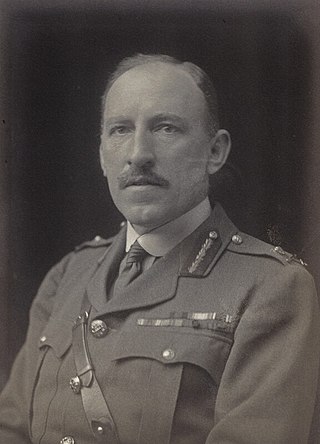Cyril Deverell
British army officer From Wikipedia, the free encyclopedia
Field Marshal Sir Cyril John Deverell, GCB, KBE, DL (9 November 1874 – 12 May 1947) was a British Army officer who served as Chief of the Imperial General Staff (CIGS), the professional head of the British Army, from 1936 to 1937. Prior to his becoming CIGS, he fought in the Fourth Anglo-Ashanti War and the First World War, during which he commanded at battalion, brigade and division level, and later advised the British government on the importance of maintaining the capability to mount an Expeditionary Force for operations on mainland Europe in the years leading up to the Second World War.
Sir Cyril Deverell | |
|---|---|
 Major General Sir Cyril Deverell in 1920 | |
| Born | 9 November 1874 Saint Peter Port, Guernsey |
| Died | 12 May 1947 (aged 72) Lymington, Hampshire, England |
| Allegiance | United Kingdom |
| Service | British Army |
| Years of service | 1895–1937 |
| Rank | Field marshal |
| Service number | 869 |
| Unit | West Yorkshire Regiment |
| Commands | |
| Battles / wars | |
| Awards | |
Early life
Deverell was born the son of Lieutenant John Baines Seddon Deverell and Harriet Strappini Deverell (née Roberts) and educated at Bedford School.[1]
Military career
Summarize
Perspective
Deverell was commissioned into the Prince of Wales's West Yorkshire Regiment on 6 March 1895.[2] He served in the Fourth Anglo-Ashanti War in 1896[3] and was then promoted to lieutenant on 3 August 1898.[4] He was appointed adjutant of his regiment on 9 February 1904[5] before being promoted to captain on 23 February 1904.[6]
Deverell served in the First World War initially as brigade major for 85th Brigade,[7] in which role he joined the British Expeditionary Force (BEF) and saw action at the Second Battle of Ypres in April 1915 before being promoted to brevet major on 3 June 1915.[3][8]

Deverell became commanding officer of the 1/4th Battalion, East Yorkshire Regiment, a Territorial Force unit, in July 1915 and was then asked to command the 20th Brigade, part of the 7th Division, from 29 October 1915,[3] after its previous commander, Brigadier General John Frederick Hepburn-Stuart-Forbes-Trefusis, had been killed. With the new command came a temporary promotion to the rank of brigadier-general.[9] Promoted to the permanent rank of lieutenant colonel on 26 August 1916, he took part in the Battle of the Somme in the autumn of 1916.[3] His brigade held a position on the 21st Division's right flank during the Battle of Bazentin Ridge and attacked the Switch Line to the east of High Wood. He was promoted to the temporary rank of major-general in August 1916[10] (and later to the substantive rank of colonel in January 1917) upon being given command of the 3rd Division[3] after its commander, Major-General Sir Aylmer Haldane, took over VI Corps.[11]
Deverell led the division at Arras in the spring of 1917, then participated in the latter stages of the Battle of Passchendaele in the final weeks of the year.[12] He returned to the Somme in 1918, before fighting alongside the Portuguese at the Battle of the Lys.[13] The division participated in the Hundred Days Offensive, finally leading to the German surrender on 11 November 1918.[12] He was appointed a Companion of the Order of the Bath in 1918[1] and awarded the Croix de guerre in 1919.[14] He remained in command of the 3rd Division until 1 January 1919, when, having been promoted to substantive major general,[15] he took over command of the 53rd (Welsh) Infantry Division.[12]
On 13 December 1921 Deverell moved to India. where he commanded the United Provinces District.[16] Having been appointed a Knight Commander of the Order of the British Empire in the 1926 Birthday Honours,[17] he served as Quartermaster-General of India from 25 February 1927[18] and, having been promoted to lieutenant general on 13 March 1928[19] and advanced to Knight Commander of the Order of the Bath in the Kings Birthday Honours 1929,[20] he became Chief of the General Staff in India in 1930.[12] He became General Officer Commanding-in-Chief of Western Command on 11 April 1931[21] and then, having been promoted to general on 21 April 1933,[22] he was appointed General Officer Commanding-in-Chief of Eastern Command on 8 May 1933.[23] He was appointed aide-de-camp general to the King on 10 February 1934,[24] and promoted to field marshal on 15 May 1936,[25] before assuming the position of Chief of the Imperial General Staff (CIGS) that same day.[12] In that capacity he advised the Government on the importance of maintaining the capability to mount an expeditionary force for operations on mainland Europe.[12] He was also colonel of the Prince of Wales's West Yorkshire Regiment from 21 March 1934, taking over from Major General Sir William Fry.[26]
In May 1937 Leslie Hore-Belisha, the newly appointed Secretary of State for War, sought to implement a new policy of limiting expenditure on the Army, particularly on the development of tanks, and when Deverell failed to show enthusiasm for that policy in the context of an increasing threat from Nazi Germany, Hore-Belisha wrote to him advising him that he had been removed from office.[1] Deverell wrote a reply to the Secretary of State, strongly objecting to the adverse comments that had been made on his own performance, and retired from the British Army on 6 December 1937.[27]
Retirement

On leaving the British Army Deverell became Deputy Lieutenant of Southampton.[28] His interests included local politics, he served on a borough council, and chaired the local defence committee during the Second World War.[1] He lived at Court Lodge in Lymington, where he died on 12 May 1947 at the age of 72.[12] His body was cremated at Bournemouth Crematorium.[29]
Family
In 1902 Deverell married Hilda Grant-Dalton; they had a son and a daughter.[3]
References
Bibliography
External links
Wikiwand - on
Seamless Wikipedia browsing. On steroids.
